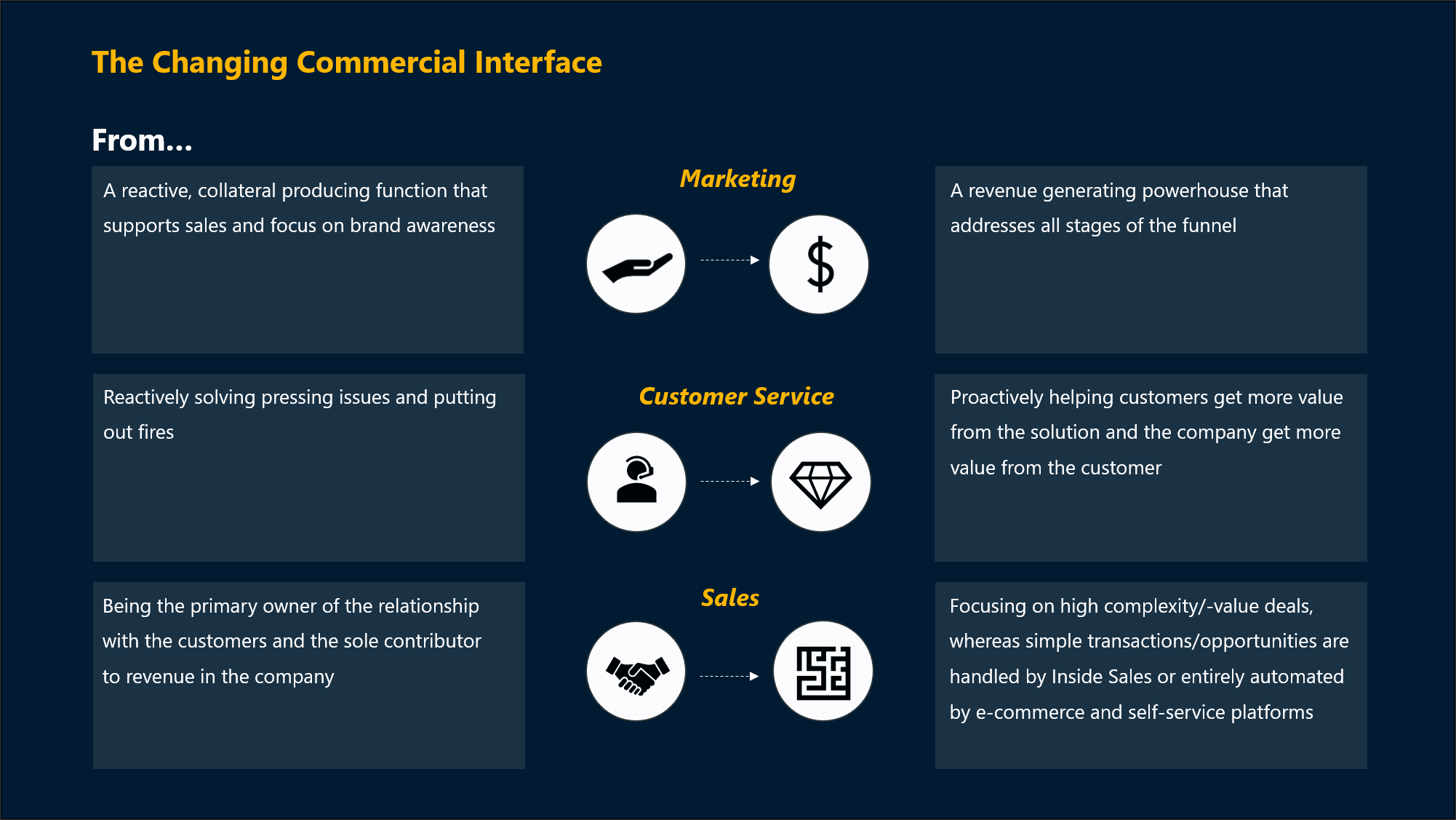The role of Chief Revenue Officer is widely adopted in SaaS companies, whereas more traditional industries have not followed suit. Instead, they often either:
- Operate Marketing & Sales as two disconnected islands without any coordination or integration
- Place Marketing & Sales under the CCO, which de facto meant that Marketing was reduced to a sales support function and internal” order-taking” advertising agency
The big question is whether BtB companies across the spectrum should introduce the role of the Chief Revenue Officer? In our view, the answer is “yes”, given they fit some key criteria and can find the right person!
The Changing Commercial Interface
While many of the foundational parts of Sales, Marketing and Customer Success have been the same for many years, we still see some seismic shift in the commercial engine-room that create a need to improve integration and collaboration across these functions:
Exhibit 1
The Changing Commercial Interface

On top of that, both sales and marketing – and the customer´s way of buying – are becoming increasingly tech-enabled. This tech-enablement provides amble of opportunities for collaboration, insight sharing, task automation and much more. Opportunities that are rarely grasped by the current – and often siloed – way of operating.
Why the current commercial model is broken
The sad truth is that the biggest challenge for most commercial organisations is the lack of alignment and integration between Sales, Marketing (and Customer Success). This lack of alignment is called “The trillion-dollar question” and can manifest itself in many ways:
1. No defined and mutually agreed lead handling processes
2. No link between the content and collateral Marketing produces, and how the salespeople sell
3. No link in value proposition or USP´s as the customer shift between sales and marketing touchpoint
4. No shared commercial strategy or go-to-market plan that both teams have contributed to and signed-off on
5. No mutual KPI framework and disjointed measures of success
6. No connected or unified tech-stack
7. No clear mandates, roles & responsibilities
8. Disconnected workflows, a lack of collaborative forums and no mutual meeting cadence
9. No sharing of insights that can be used outside of the siloes they were generated
10. A lack of trust and maybe even professional respect
These challenges provide the platform from which the CRO can add value – instead of trying to master all the technical parts of Marketing, Sales and Customer Success at once.
When companies should hire a CRO and when they shouldn’t
Introducing a Chief Revenue Officer can potentially shake up a lot of things and create immense value, but it is not necessarily relevant to all B2B companies:
- The value from a CRO is the highest when all commercial engines are crucial enablers of growth, and when the customers switch between Sales, Marketing and Customer Success governed touch-points on a regular basis
- The value from a CRO is the lowest when the customers still expect their sales counterparts to “own” most of the customers’ buying process (In this environment Marketing has little opportunity to influence buying behaviour).
If the latter is the case for your industry and company, introducing a CRO is not the right thing to do, but keep in mind that the circumstances outlined are increasingly the exception rather than the rule.
The CRO as the great mediator and direction setter
The truth is that Sales & Marketing (and to some extend Customer Success) are very different disciplines yet they still support the same flow: Generating demand, capturing demand, landing customers and expanding customers.
We have huge regard for the difference between these disciplines, that is why we also believe that a major pitfall is to expect that a CRO can master all of these. Instead, the CRO role should help facilitate a fluid collaboration and ensure that everyone is walking in rhythm. By looking at the CRO through this lense, we can outline some key activities that the role should be responsible for:
1. Collaboration and integration: Ensure coordination, alignment and a culture of collaboration
2. Leadership and management: Lead and coach the department heads
3. Strategic direction setting: Drive the commercial strategy formulation and execution
4. Measurement and performance tracking: Create a shared KPI framework and own the full picture of the funnel to identify leaks and compare revenue sources
5. Budget allocation and investments: How to balance spend between hiring more outbound salespeople, setting up an Inside Sales team, turning up Marketing spend or whatever the dilemmas are.
The next question is, who the ideal candidate is for this elusive job?
CRO: In Search of a Hybrid Profile
The CRO profile is indeed a hybrid profile with some technical and strategic understating of both Marketing & Sales. The pitfall is to by default promoting either the Head of Marketing or Head of Sales to be the CRO:
1. Promoting the legacy head of Sales
The challenge with this prototype is, that they rarely can turn Marketing into a strategic asset, as they often lack the training in marketing fundamentals, the experience from especially digital marketing and tend to discount the value of marketing in general as it historically has been subservient to sales.
2. Promoting the legacy head of Marketing
On the other end of the spectrum too many marketers have a one-eyed focus on “Brand”. While “Brand” is hugely important, if the “demand” side is not added to the mix there is no platform to collaborate with Sales around. The sales process (not the marketing funnel) is the anchor that Sales, Marketing and Customer Success should use to collaborate around, yet, too many marketers think that the role of Marketing ends at brand awareness and maybe MQL’s.
While the above prototypes seem a bit extreme, you will find profiles that can connect the two worlds, but be sure to check for this holistic view and expanded toolbox. Based on this premise, we end up at the million-dollar question: Where do I find these profiles? The answer is that they – unfortunately – are in short supply.
It’s all about the person!
So, don’t just insert a CRO because you “need the role” – it is really about the person. And if you don’t have that person it is better to keep a Head of Sales and marketing and have the report to the CEO, that can spend some of his/her scarce time on ensuring collaboration and strategic direction setting.
In sum, in B2B companies of all shapes and sizes, there is definitely a need for a CRO, but the question remains, who should fill the chair?









